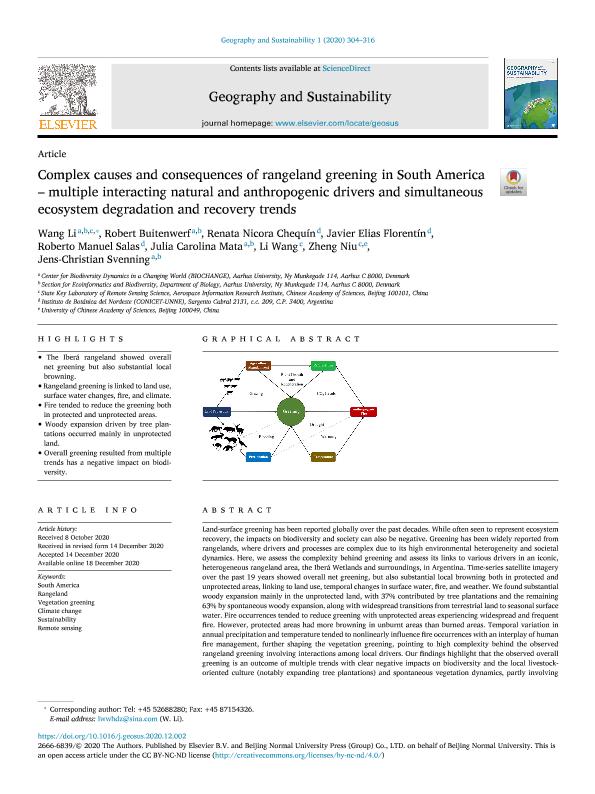Artículo
Complex causes and consequences of rangeland greening in South America – multiple interacting natural and anthropogenic drivers and simultaneous ecosystem degradation and recovery trends
Li, Wang; Buitenwerf, Robert; Nicora Chequín, Renata ; Florentín, Javier Elias
; Florentín, Javier Elias ; Salas, Roberto Manuel
; Salas, Roberto Manuel ; Mata, Julia Carolina; Wang, Li; Niu, Zheng; Svenning, Jens-christian
; Mata, Julia Carolina; Wang, Li; Niu, Zheng; Svenning, Jens-christian
 ; Florentín, Javier Elias
; Florentín, Javier Elias ; Salas, Roberto Manuel
; Salas, Roberto Manuel ; Mata, Julia Carolina; Wang, Li; Niu, Zheng; Svenning, Jens-christian
; Mata, Julia Carolina; Wang, Li; Niu, Zheng; Svenning, Jens-christian
Fecha de publicación:
12/2020
Editorial:
Elsevier
Revista:
Geography and Sustainability
ISSN:
2666-6839
Idioma:
Inglés
Tipo de recurso:
Artículo publicado
Clasificación temática:
Resumen
Land-surface greening has been reported globally over the past decades. While often seen to represent ecosystem recovery, the impacts on biodiversity and society can also be negative. Greening has been widely reported from rangelands, where drivers and processes are complex due to its high environmental heterogeneity and societal dynamics. Here, we assess the complexity behind greening and assess its links to various drivers in an iconic, heterogeneous rangeland area, the Iberá Wetlands and surroundings, in Argentina. Time-series satellite imagery over the past 19 years showed overall net greening, but also substantial local browning both in protected and unprotected areas, linking to land use, temporal changes in surface water, fire, and weather. We found substantial woody expansion mainly in the unprotected land, with 37% contributed by tree plantations and the remaining 63% by spontaneous woody expansion, along with widespread transitions from terrestrial land to seasonal surface water. Fire occurrences tended to reduce greening with unprotected areas experiencing widespread and frequent fire. However, protected areas had more browning in unburnt areas than burned areas. Temporal variation in annual precipitation and temperature tended to nonlinearly influence fire occurrences with an interplay of human fire management, further shaping the vegetation greening, pointing to high complexity behind the observed rangeland greening involving interactions among local drivers. Our findings highlight that the observed overall greening is an outcome of multiple trends with clear negative impacts on biodiversity and the local livestock-oriented culture (notably expanding tree plantations) and spontaneous vegetation dynamics, partly involving spontaneous woody expansion. The latter has positive potential for biodiversity and ecosystem services in terms of woodland recovery, but can become negative in such a natural savanna region if expansions develop on a too broad scale, highlighting the importance of ensuring recovery of natural fire and herbivory regimes in protected areas along with sustainable rangeland management elsewhere.
Archivos asociados
Licencia
Identificadores
Colecciones
Articulos(IBONE)
Articulos de INST.DE BOTANICA DEL NORDESTE (I)
Articulos de INST.DE BOTANICA DEL NORDESTE (I)
Citación
Li, Wang; Buitenwerf, Robert; Nicora Chequín, Renata; Florentín, Javier Elias; Salas, Roberto Manuel; et al.; Complex causes and consequences of rangeland greening in South America – multiple interacting natural and anthropogenic drivers and simultaneous ecosystem degradation and recovery trends; Elsevier; Geography and Sustainability; 1; 4; 12-2020; 304-316
Compartir
Altmétricas



